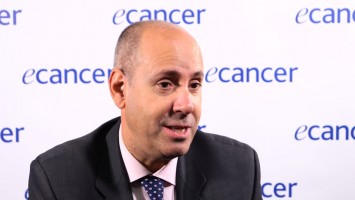ASCO 2015
Anastrozole offers higher breast cancer-free survival rates than tamoxifen following DCIS
Prof Richard Margolese - The Jewish General Hospital, McGill University, Montreal, Canada
What is all the big fuss about DCIS and why are people thinking of adding more therapies, first of all, to it? Because you’ve got a new one.
DCIS is a risk factor for cancer, if nothing else. So to keep it from coming back or from escalating to invasive cancer with the possibility of metastases seems a sensible thing if you have a safe and effective way of doing that.
Preventing recurrence or preventing further cancer is a worthy aim, you’re trying adding anastrozole. Why and what exactly was the comparison that you were doing here?
Twenty years ago we did a study with tamoxifen against no treatment showing that it helped prevent recurrences and helped prevent the incidence of invasive cancer and we think that’s a good idea. Now anastrozole is in a class of drugs that looks like it might be better because it’s a better suppression of oestrogen signalling and it might be safer. So the study was done to establish that.
So tell me what you did in your study?
In this study?
Yes.
In this study we took women with DCIS who had been treated by breast conserving surgery and radiation and we randomly assigned them to receive either tamoxifen or anastrozole in a double blind fashion so they didn’t know which pill was which. We found that the anastrozole produced a better protection against the occurrence of cancer and it was probably a better safety profile. I say probably because there are nuances.
In round figures, and I’ll ask you about the nuances in a minute, in round figures what was the level of additional protection given by anastrozole?
It was different for women who were younger than 60 where the protection, the hazard rate, was about 0.5 with a good p-value. In women older than 60 tamoxifen and anastrozole were equivalent.
And of course this was all post-menopausal women, wasn’t it?
All post-menopausal women, all ER positive.
So what are the clinical implications coming out of this?
In general, women with DCIS are treated with tamoxifen after surgery, it’s beneficial. And now we have another drug, another option for women where perhaps the side effects are a consideration, like a person with a history of thromboembolism or someone who is worried about uterine cancer. Anastrozole can be used without those problems, it doesn’t carry those problems.
What about the different side effect profile, though, of anastrozole as compared with tamoxifen?
Anastrozole tends to produce more fractures because it’s depriving women of oestrogen and tamoxifen tends to strengthen bones, it has an oestrogenic activity. The difference is slight and it was not statistically significant although it’s numerically different.
So what are the clinical implications, in your view, coming out of this?
The clinical implications are that if I had a post-menopausal woman with DCIS and we were going to do adjuvant treatment I would select anastrozole as a more effective and safer drug.
So what do you advise doctors to say to their patients in introducing the subject and coming to a joint decision?
I think the first lesson is that in ten years of follow-up 90% of our patients are still well. So the difference is a little more than 90 versus a little less than 90. But it is a statistically significant and useful difference and so I think it is wise to give some adjuvant therapy in the sense of cancer prevention because we’re much more worried about invasive cancer than a recurrence of DCIS and that anastrozole has a safer profile.
Does this mean that you tend to go now for anastrozole in this setting?
Yes, I hope that’s what I said.
Finally, what should doctors be taking home from this then?
In terms of adjuvant therapy for DCIS anastrozole prevents invasive cancer which is important and it has a safer profile in terms of adverse events.








